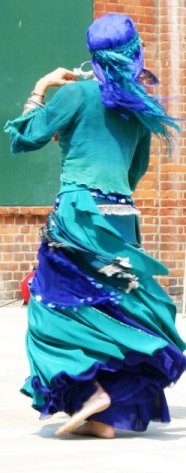
 The sinuous and percussive movements of this dance style are based on the traditional dances of Egypt and accompanied by the hypnotic rhythms of darbuka and douff: drums that have barely changed for centuries.
Egyptian dance is beoming increasingly popular in the West as an alternative way of keeping fit and having fun. To download my handout An introduction to Raqs Sharqi: click here.
There are three main forms of oriental dance - sometimes called Raqs Sharqi or bellydance:
- Sharqi (classical: based on dances originally performed in the Ottoman courts combined with influences of the takt or 'enchantment' music)
- Sha'abi (folk: based on the Ghawazee gypsies, the Fellahin or farmers, and from the Said or Upper Egypt)
- Baladi (urbanised folk music which evolved during the early part of the 20th century and often called Egyptian jazz).
Each form has its own convention of music, emotional feel and costume but these distinctions are far from clear cut. Egyptian dance isn't narrative, nor do the movements hold any particular meaning. It is interpretive, expressive and could be described as music seen in 3D. Whilst primarily an improvised form, particularly when danced solo, groups may sometimes perform a set choreography.
One main feature of this dance is groundedness. A good way to define this is to say that if ballet is a horizontal dance (lots of travelling around the stage and a feeling of lightness), Egyptian dance is more vertical (very centred with movements rarely straying from a connection to the earth and emmanating from the core).
This dance style is constantly evolving: new styles have emerged mixing bellydance with other traditional ethnic styles including Indian, Flamenco, Thai, street dance and even Gothic. These Tribal/Fusion styles originated mainly in America and offer a different look, feel and structure to Egyptian-based styles, often with amazing costumes. I still love the more traditional style I first discovered.
We dance for laughter, we dance for tears; we dance for madness, we dance for fears,
We dance for hopes, we dance for screams; we are the dancers, we create the dreams. (Unknown)
|